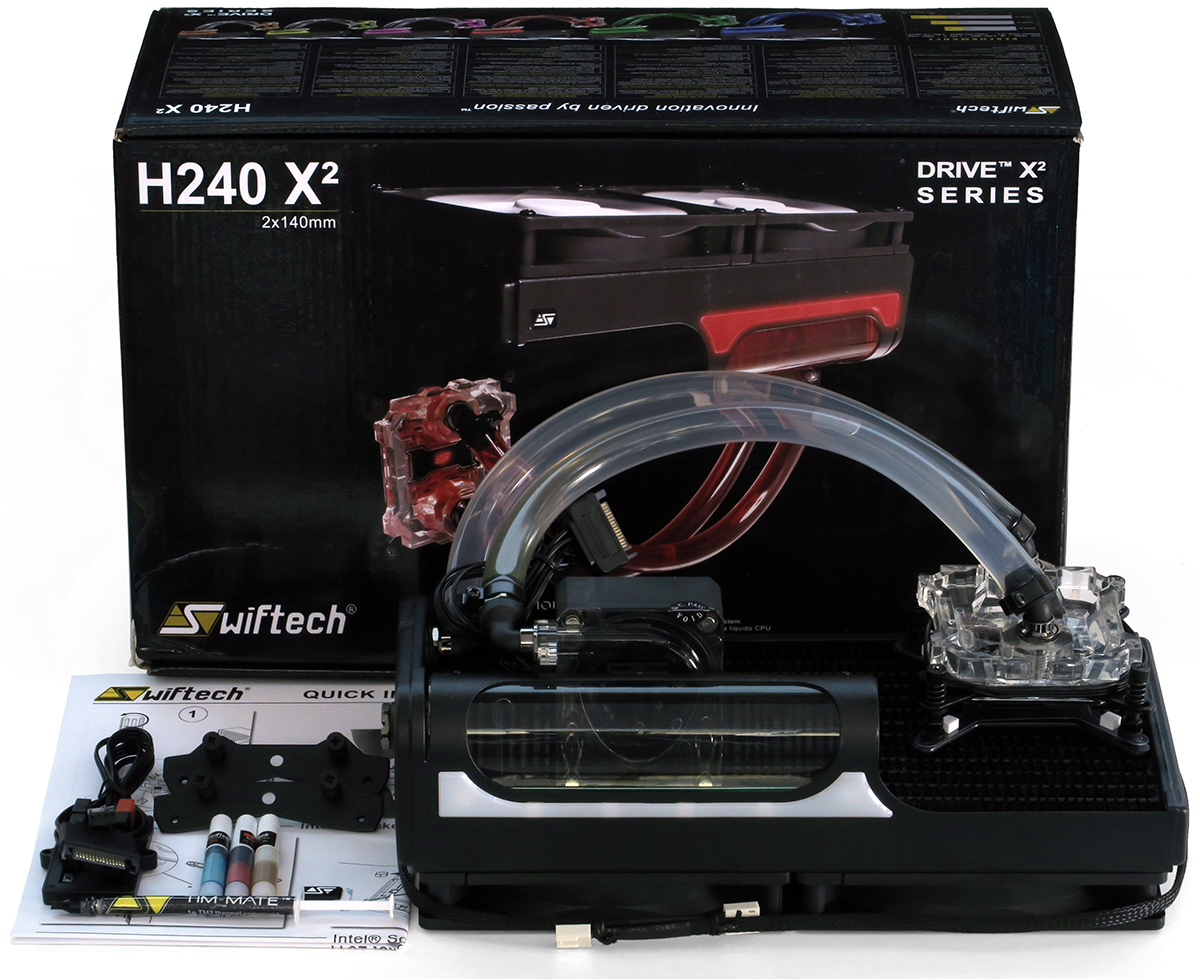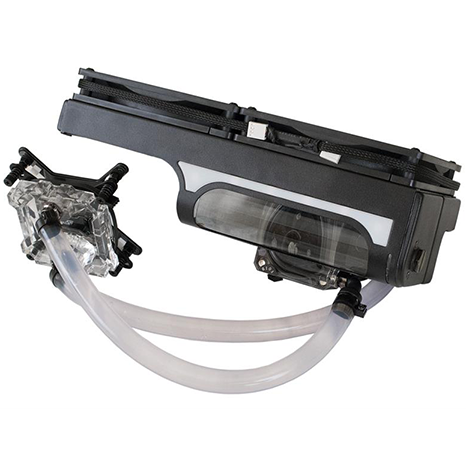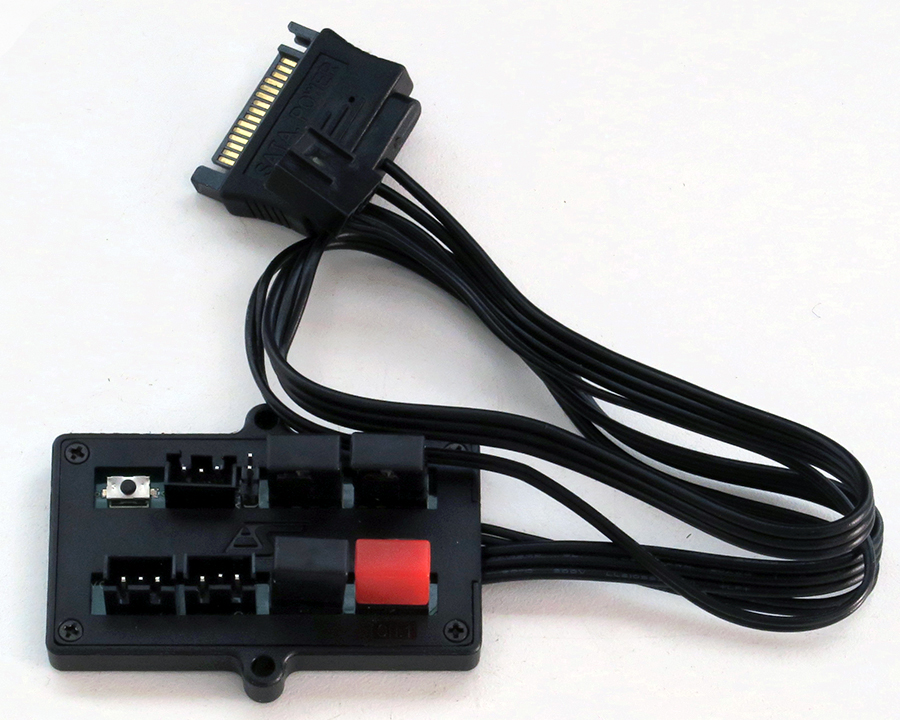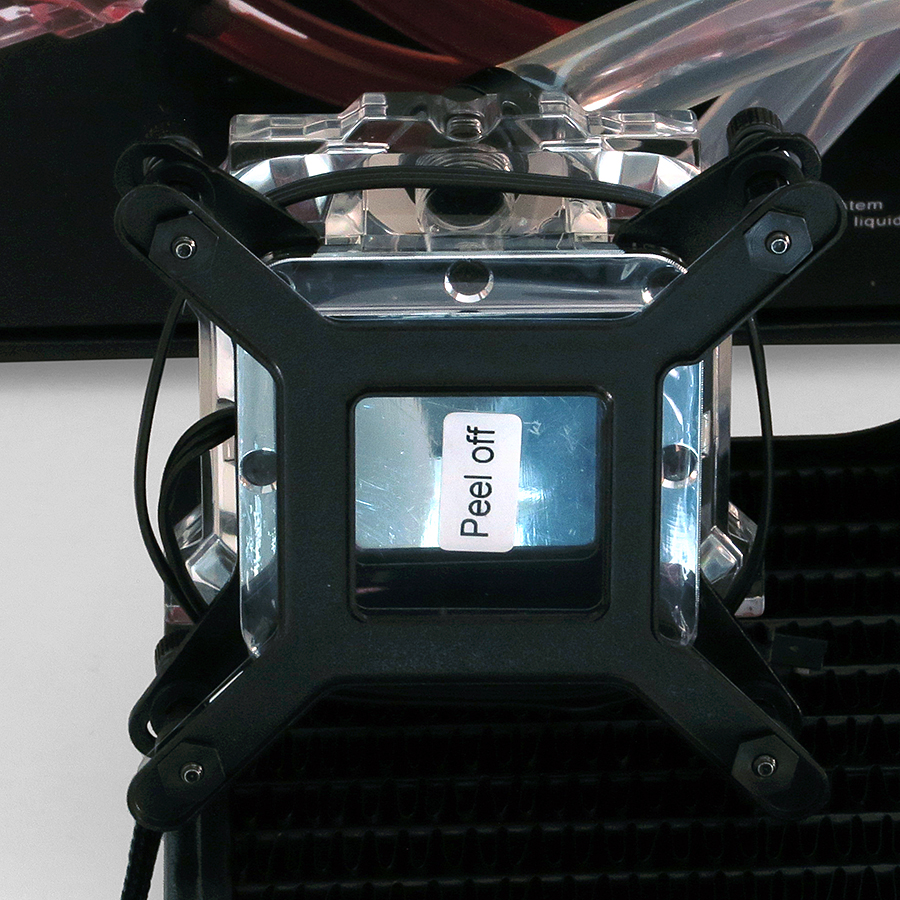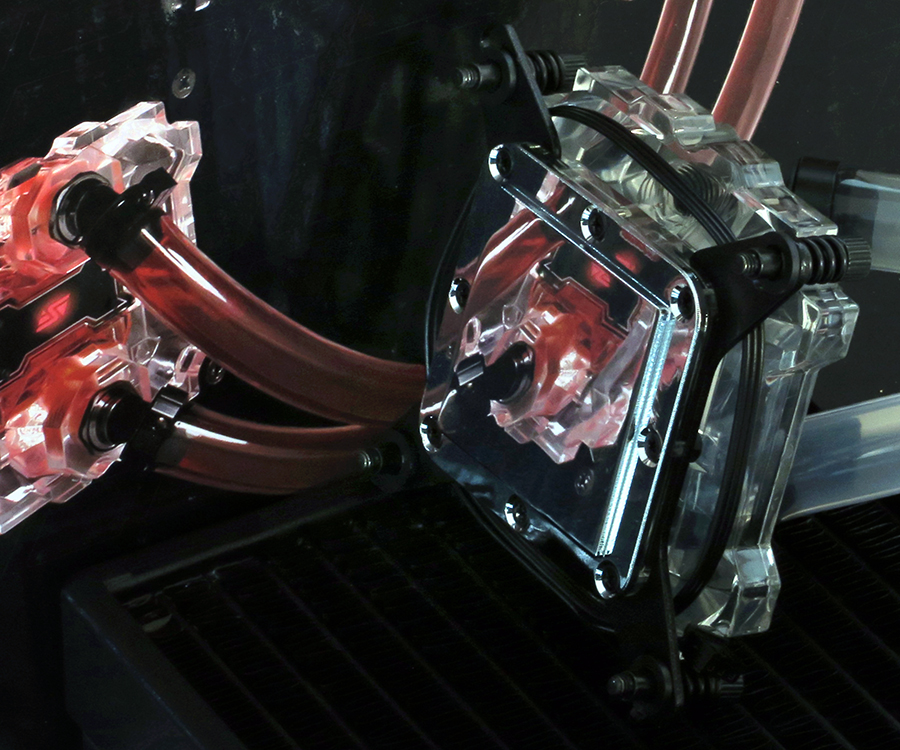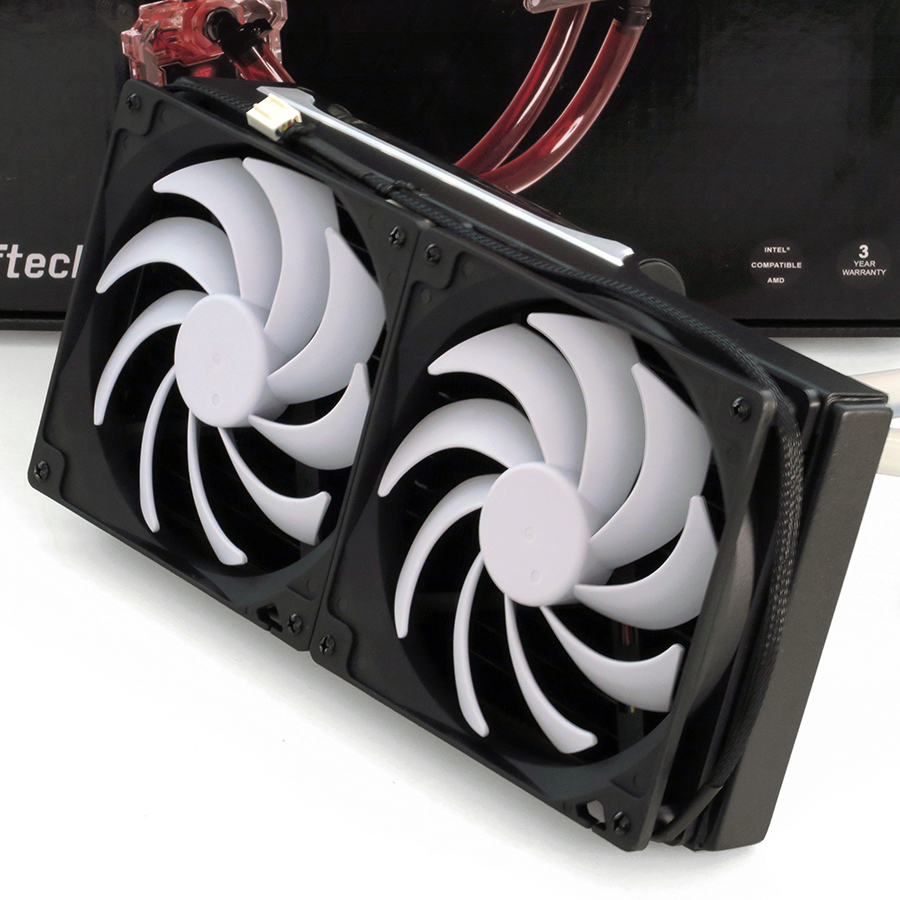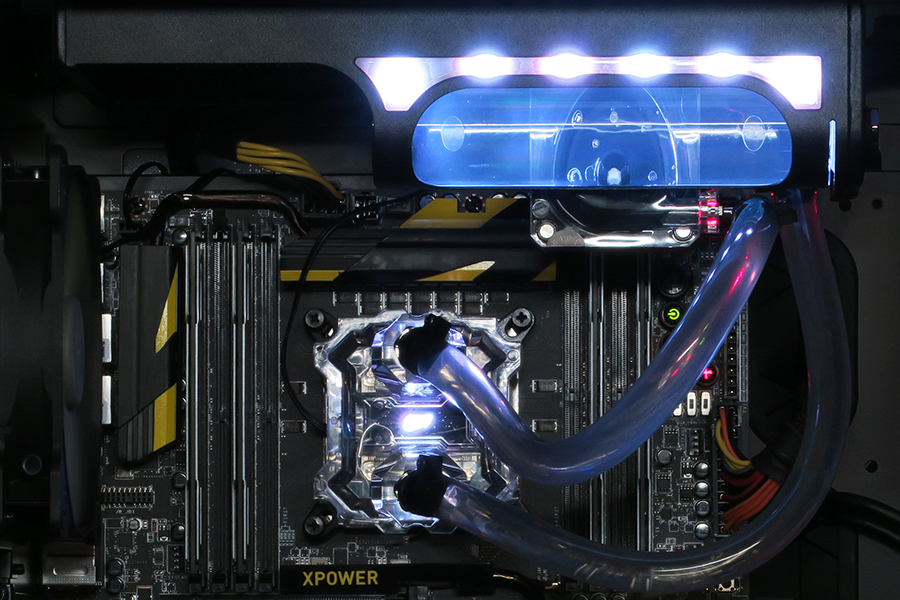Early Verdict
All of the coolers we compared today had more than enough capacity for our overclocked six-core processor, but only Swiftech's H240 X2 has provisions to use that extra capacity to cool the added component of the builder's choice.
Pros
- +
Good cooling
- +
Enhanced lighting features
- +
Closed-loop convenience
- +
Open loop configurability
- +
Moderately-sized pump designed to handle an additional component or two
- +
Extends motherboard-based "CPU fan" speed control to entire cooling system
Cons
- -
Fans fit only the top side of the radiator
- -
Hanging pump and reservoir conceal upper DIMM latches
Why you can trust Tom's Hardware
Introduction, Specifications And Features
Tom's Hardware has tested many cooling devices, but open loops are rarely among them. The reasons for that are numerous, beginning with the fact that most open-loop systems are built from custom-selected components. A rash of complaints always follows any selections made by us, so we leave those choices to the manufacturer. The open loops we've tested have primarily been complete component kits.
The benefit of an open loop should be obvious to anyone who has ever wanted to add an extra component, such as a graphics card block, to their installed radiator and pump. This simply can't be done with closed-loop hardware, at least without hacking it up and voiding the warranty. Most closed loops don't even have the fill ports present on Swiftech's factory-filled configurations.
That's not to say closed loops lack benefits. The previously-mentioned novice can install one of these without worrying about getting the line length right, filling the entire loop, or priming the pump (they don't pump air after all). There's no vent for liquid to evaporate out of or get contaminants into, and no practical reason to blame yourself for a leak (unless you damage something).
Using standard 3/8" tubing and standard G1/4 port threads, Swiftech's pre-filled cooling systems allow users to switch from one set of advantages to the other as their courage builds. The H240 X2 includes two 140mm Swiftech Helix fans, the firm's Apogee XL2 CPU water block, a custom radiator with integrated 11 liters/minute pump and acrylic reservoir, AMD and Intel mounting kits, Swiftech Tim-Mate 2 thermal compound, a fan hub with LED controller, and three colors of liquid coolant dye.
As shown in Swiftech's product image, the best reason for the system to ship with clear coolant and include extra dye is to match the lighting modes of its LED controller. We'd like to suggest trying the various lighting modes inside your case prior to attempting to match the coolant color to the lighting.
Specifications
MORE: Best Cooling
MORE: Best CPUs
MORE: Best CasesMORE: All Cooling Content
Features
Lighting modes are controlled via a tiny button on the fan hub, but the hub also has a pair of pins for those who would like to add an external button. We might have suggested a bay panel switch, if not for the popularity of bay-free cases. Interfacing a motherboard's CPU fan header and powered by a SATA power cable, the fan hub uses that PWM signal to control both the pump and fan speeds.
Get Tom's Hardware's best news and in-depth reviews, straight to your inbox.
The H240 X2 is packaged with Intel mounting brackets installed. The motherboard support plate is spaced only for LGA 115x (1156, 1155, 1150, 1151) interfaces, and the top bracket's screw holes are slotted to support the threaded mounts of square ILM LGA 2011x (2011 and 2011-v3). AMD users need only remove their factory four-screw clip bracket in addition to replacing Swiftech's Intel kit with its AMD kit. Users of Intel's LGA 1366 or those with pinned-on AMD clip brackets will need to purchase a threaded support plate separately.
Removing the support plate and protective sticker, we find a highly-polished and supremely flat base on the Apogee XL2 water block. The top bracket is threaded for LGA 2011x, and uses short standoffs to fit the finer threads of the LGA 115x support plate.
Swiftech rates its Helix fans at 700-1800 RPM and 35-90 CFM at 2.4W.
I'd love to devote a page to H240 X2 installation, but we're using an LGA 2011-v3 motherboard and it simply screws onto the motherboard's integrated support plate. Of course we applied thermal paste before installation, and followed up by plugging the fans into the fan hub. The hub's single PWM cable feeds back only pump RPM to the motherboard's fan sensor.
-
basroil This thing loses out hard to the X61...Reply
Also, the testing method is pretty bad. Like silentpc review you should really test units using a known fan as well as default ones to isolate sources of noise and performance. -
Samer1970 This review is a bad review . people use water cooling to test extreme OC and you guys only test 4.2 ghz OC results ?Reply
you should stress this cooler until it fails to know the maximum cooling of it , and no one cares about comparing with other coolers , that one can be put in a separate table.
no one buys such expensive cooler just to OC to 4.2 Ghz only which can be reached using cheap $40 air cooler . so this review is zero and tells nothing.
and if you want to compare , COMPARE in a stand alone table and make anther table for the maximum cooling of this cooler until it fails -
Samer1970 Reply17915955 said:This thing loses out hard to the X61...
Also, the testing method is pretty bad. Like silentpc review you should really test units using a known fan as well as default ones to isolate sources of noise and performance.
not really , such cooler wins in extreme overclocking in which the X61 cant match ... they just tested it for low 4.2Ghz oc here thats why the potential of this cooler is not shown ... -
toddybody Looks overly complicated for an AIO...I'd much prefer the EK Predator (though more $$) or a simple loop w/ flex tubing. Res/Pump combo's have made loops super simple.Reply -
thundervore Why the hell is a 240 liquid CPU cooler being compared to a 280 liquid CPU cooler?Reply
Its common sense that the 280 will pull out in front due to more surface area to dissipate heat.
Why wasn't it compared to the other 240 coolers that are more known like the many repetitive crap Corsair puts out every 18 months?
Why is the EK Predator not even on this chart?
So many questions with obvious answers which means this review was not clearly though out. -
g-unit1111 Reply17915646 said:Why is this not being compared to the EK Predator?!
Yeah that would be an interesting comparison, especially for people who are interested in liquid cooling but not so much CLLs. This and the Predator are a nice step between a CLL and a full loop.
This thing loses out hard to the X61...
It does? I get better temps with my Cryorig R1 than I did with my X61. My X61 is currently sitting in my closet. -
TbsToy The EK Predator thing is a piece of junk. It is slapped together by a bunch of kids who have no real idea what they are doing. Hands on has proven this out to be true.Reply
W.P. -
Dunlop0078 ReplyThe EK Predator thing is a piece of junk. It is slapped together by a bunch of kids who have no real idea what they are doing. Hands on has proven this out to be true.
W.P.
Really? Sources? Every review I have read of the EK predator has been favorable and I have used plenty of EK products in the past with no issues. I think its a bit expensive but I dont believe it was "slapped together by a bunch of kids who have no real idea what they are doing". Seems a bit harsh. -
jasonelmore ReplyLooks overly complicated for an AIO...I'd much prefer the EK Predator (though more $$) or a simple loop w/ flex tubing. Res/Pump combo's have made loops super simple.
EK Predator is ugly.
Swiftech knows a bit more about AIO than EK.. They taught EK how to do water cooling back in the day.
